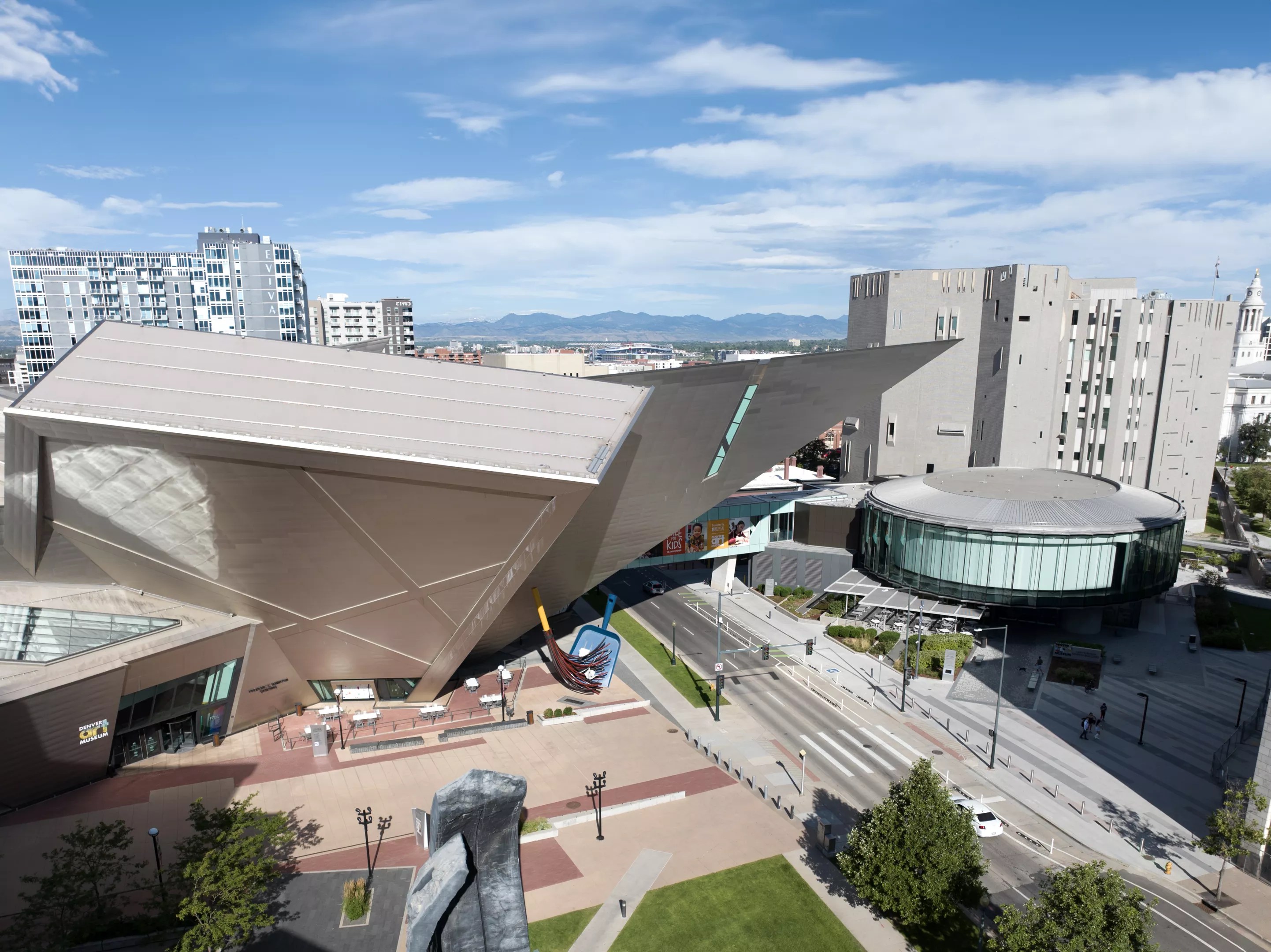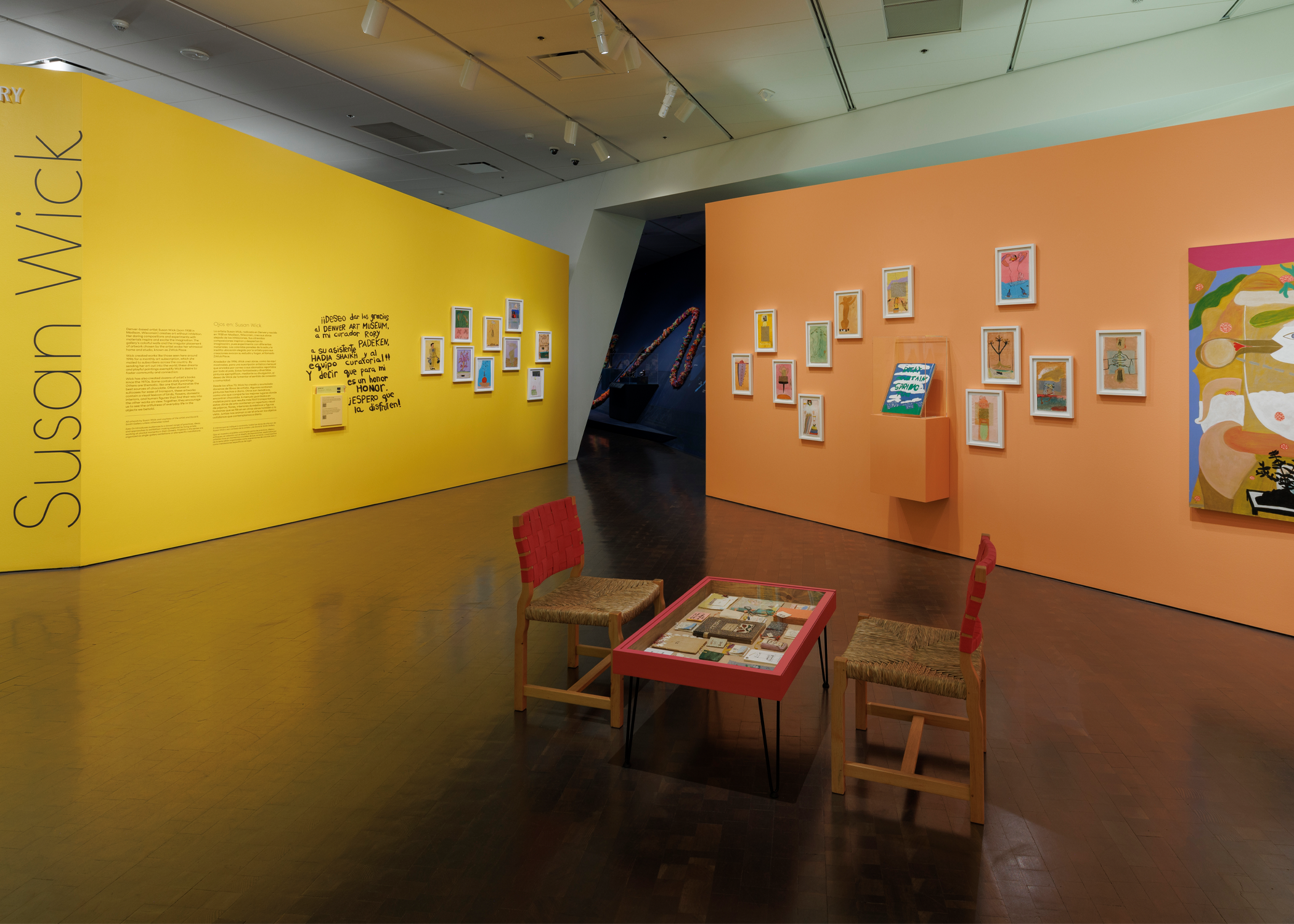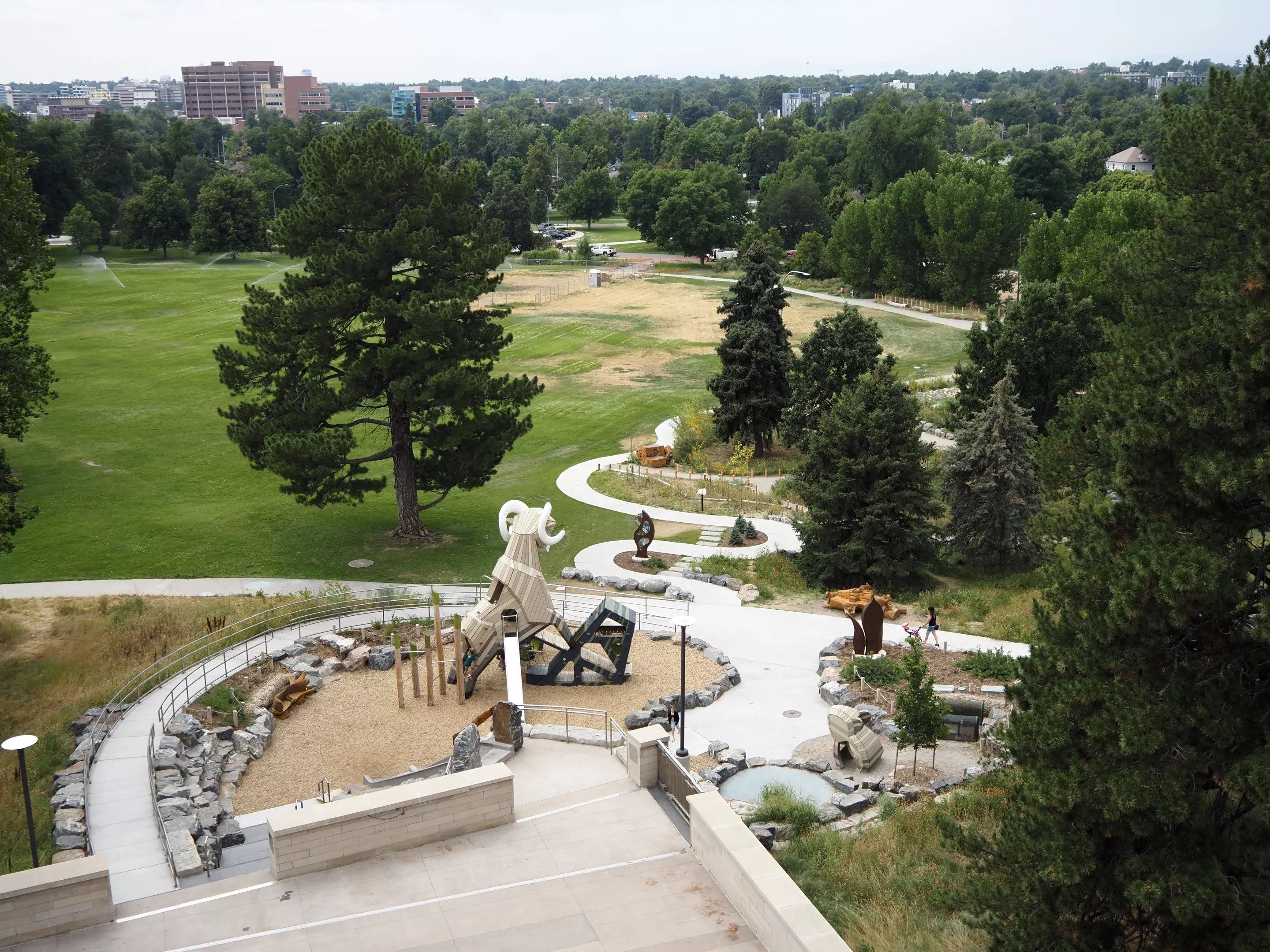
Photo by Visit Denver

Audio By Carbonatix
Arts and culture have been a significant part of the human experience for as long as humans have existed, but in modern times, those experiences are usually the first to be cut from budgets. That’s certainly what was happening in Denver in the late 1980s, when the metro economy faced a serious economic downturn during that decade’s oil bust.
Many cultural organizations were on the brink of collapse after rapidly losing city and state funding. That’s when a group of local individuals and organizers, along with political and community leaders, pushed for a regional tax that would give one penny from every $10 purchase back to cultural institutions across seven counties: Denver, Boulder, Jefferson, Adams, Arapahoe and Douglas (Broomfield was added later). The tax proposal passed in 1988 with 67 percent of voters in favor, and the Scientific and Cultural Facilities District was born.
SCFD, which has been renewed by voters three times since its founding nearly forty years ago (the last was in 2016; it will be on the ballot again in 2028), is the only cultural funding model in the U.S. to serve a region of seven counties. Today, it distributes more than $80 million each year to nearly 300 organizations in the region, ranging from the Art Students League of Denver to the Black American West Museum & Heritage Center, the Boulder Symphony and the Chicano Humanities and Arts Council.
The money makes “Free Days” possible, giving people hundreds of opportunities each year to get into SCFD-funded museums and institutions for free. “It’s thanks to SCFD Free Days that I was exposed to the arts and culture from a young age,” says SCFD’s new executive director, Andrea Albo, who started her role this month. “I am looking forward to working with the cultural community I call home to advance the accessibility of arts, culture and science for all district residents.”
Denver, make your New Year’s Resolution Count!
We’re $14,000 away from our End-of-Year campaign goal, with just a couple of days left! We’re ready to deliver — but we need the resources to do it right. If Westword matters to you, please contribute today to help us expand our current events coverage when it’s needed most.
“This funding allows our grantees to do what they do best for the good of the community, whether that’s presenting new exhibitions or theatrical productions, stewarding citizen science projects or expanding education programs, hosting Free Days or collaborating with other organizations to reach new audiences,” adds Jessica Kato, deputy director of SCFD.
SCFD funding cannot be used for capital projects, acquisition of buildings or creation of a building or endowment, payment of debt, re-granting of funds to other organizations, scholarships, or expenditures in excess of $10,000 in a single year for either improvements to freestanding exhibits or physical accessibility improvements.
But the funding does help Colorado’s cultural organizations work together rather than separately, points out Janice Sinden, president and CEO of the Denver Center for the Performing Arts. “Through SCFD, voters have expressed their desire to have a culturally vibrant community – one that inspires, educates, engages and entertains everyone every day,” she says. “This support sets us apart from any other community in the nation, if not the world.”
The DCPA is one of the five institutions in SCFD’s top tier – arts, culture and science organizations that are large economic drivers for the metro area and receive more than half of SCFD’s funds as a result. The other four are the Denver Art Museum, the Denver Botanic Gardens, the Denver Museum of Nature & Science and the Denver Zoo Conservation Alliance. In 2024, those five organizations received more than $51 million total in SCFD funding; they’re expecting a little more this year.
SCFD has two other tiers. Tier II organizations receive 22 percent of the funds and include institutions such as Central City Opera, the Butterfly Pavilion, the Museum of Contemporary Art Denver and the Colorado Railroad Museum. Tier III recipients receive 14 percent of the funds and include an array of smaller organizations ranging from RedLine Contemporary Art Center to Su Teatro Cultural and Performing Arts Center and Cleo Parker Robinson Dance. While arts advocates occasionally complain about how SCFD funds are distributed, there’s no denying how the tax has enriched the overall cultural scene over the decades.
Tier I representatives say they consider their role as SCFD’s top grantees an honor and a great responsibility. Westword checked in with each of the SCFD’s Tier I institutions on what this great responsibility has enabled them to do.

Eyes On: Susan Wick is in the Hamilton Building’s Modern and Contemporary Art Galleries at the DAM.
Courtesy of Denver Art Museum
Denver Art Museum
In 2024, the Denver Art Museum received $10,379,035 in SCFD funding; it’s expecting a similar sum this year, according to Christoph Heinrich, the DAM’s Frederick and Jan Mayer Director. The DAM includes hundreds of thousands of square feet of permanent and temporary art exhibits that span multiple floors, buildings, eras and cultures in Denver’s Golden Triangle Creative District.
“The funding helps the DAM broadly serve the community and collaborate creatively with our SCFD peers, local artists and organizations, as well as national and international collaborations that build the reputation of the museum and the Denver metro area,” Heinrich says.
For the DAM, this looks like monthly Free Days and free family festivals, such as Día del Niño and the Annual Friendship Powwow, a community celebration highlighting Native American art and culture that celebrated its 36th year at the beginning of September.
“SCFD funding also bolsters the DAM’s school, family and access programs – such as our Sensory Friendly Mornings – as well as our presentations of world-class art exhibitions and the conservation of the museum’s collections so they can be enjoyed for generations to come,” Heinrich continues.
He adds that SCFD lowers barriers to entry for museums and cultural organizations, including language barriers: The DAM is the first museum in the metro area to become fully bilingual in English and Spanish across its entire campus.
Additionally, the Kirkland Museum of Fine & Decorative Art merged with the DAM last year, and Heinrich says museum staff worked to ensure that the Kirkland experience would be enjoyable for younger visitors while keeping the collection safe by incorporating more family-friendly elements such as Bloomberg Connects tours, a family area and art activities.

Volunteers help plant thousands of tulip bulbs at the Denver Botanic Gardens in October. The flowers bloom in the spring.
Kristen Fiore
Denver Botanic Gardens
In 2024, the Denver Botanic Gardens received $6,764,496 in SCFD funding and anticipates a little more this year, according to DBG Interim Director of Marketing and Social Responsibility Erin Bird. The DBG’s mission is to connect people with plants across its three campuses – York Street in Denver, Chatfield Farms in Littleton and that Plains Conservation Center in Aurora – through therapeutic horticulture programs, art, urban food access, conservation efforts and more.
SCFD funding makes it possible for the DBG to host 24 Free Days a year across its three locations and supports mission-focused efforts such as horticulture, art and exhibitions, research and conservation, the Helen Fowler Library and Chatfield Farms, Bird adds.

Pumpkin Festival at Denver Botanic Gardens’ Chatfield Farms.
Kristen Fiore
Longtime DBG CEO Brian Vogt died earlier this year; according to Bird, the DBG staff is dedicated to continuing Vogt’s efforts of ecological conservation, research, community events and rotating art exhibitions at its Freyer-Newman Center.
Agave: Symbol and Spirit, an exhibit about the succulent plant’s cultural and spiritual role in Mexico, and Nourished, Works by Jazz Holmes, a display honoring Southern American food culture through artworks celebrating Creole dishes, open September 28. Xochimilco: Works by Eduardo Robledo Romero, opens October 11, displaying the works of Mexican artist Eduardo Robledo Romero, which focus on animal spirit guides and shamans and explore “the complex ties that bind Mexican culture to the natural world through both Indigenous and European beliefs.”
This fall, people can also look forward to popular events like Glow at the Gardens (York Street), the Pumpkin Festival (Chatfield Farms), Ghosts in the Gardens (York Street) and an expansive display of butterflies during Yo Soy: Mariposas Sin Fronteras (York Street).

Ryan Conarro in DCPA’s Sweet & Lucky: Echo, which runs through Sunday, October 5, at DCPA Off-Center at Broadway Park.
Courtesy of Jamie Kraus Photography
Denver Center for the Performing Arts
In 2024, the Denver Center for the Performing Arts received $9,026,136 in SCFD funding. The DCPA offers locally produced theater productions as well as touring Broadway shows, offers education programs and features more activities at nine venues around the Mile High City. Sinden says that early estimates indicate that SCFD funding helped the DCPA “offer more than 985,000 engagement opportunities through theatrical productions, educational programs, community engagement events and venue rentals” during its 2024/25 season.
The funding has also allowed affordable ticketing opportunities such as rush tickets for seniors, students and military members; free tickets to individuals who would otherwise be unable to attend a performance (nearly 12,000 of those tickets were distributed in 2024); and invitations for partners to attend dress rehearsals at no cost.
The DCPA also works to engage the community through free Shakespeare in the Parking Lot performances, community dance classes, and partnerships with other SCFD-funded organizations such as Wings Over the Rockies Air & Space Museum, Opera Colorado and the Denver Public Library.
“SCFD funds are regularly used to support original work by the Denver Center Theatre Company (typically an eight-play season), DCPA Off-Center (typically one or two annual productions) and new play development through commissions, workshops and public readings,” Sinden adds.
This fall, patrons can attend the Young Audiences production of Goodnight Moon (October 24 through January 25), the Denver Center Theatre Company production of Cat on a Hot Tin Roof (October 3 through November 2) and national touring productions of Shucked (October 7 through October 19) and The Lion King (October 23 through November 16).

The Denver Museum of Nature & Science is celebrating 125 years this year.
Richard Wicker/DMNS
Denver Museum of Nature & Science
In 2024, the Denver Museum of Nature & Science received $12,507,937 in SCFD funding, the highest sum of the five Tier I recipients. This year, the DMNS celebrates its 125th anniversary of bringing the world to Colorado through its 711,000-square-foot campus in City Park and its collection of more than 4.3 million objects – from taxidermy dioramas and dinosaur bones to gems and minerals and a state-of-the-art planetarium.
“In 2024 alone, SCFD funding allowed us to serve more than 2 million people, with more than two-thirds of those attendees benefiting from free or reduced access,” says DMNS Vice President of Strategic Partnerships Jacqueline Altreuter. “That means over 1.1 million people could experience our exhibitions, programs and resources without the barrier of cost.” The SCFD enabled the DMNS to host more than a dozen Free Days and provide reduced-cost access for the thousands of visitors who receive SNAP benefits.

DMNS partnered with Denver Parks & Recreation to open Nature Play, a 4-acre immersive outdoor experience in City Park.
Kristen Fiore
Altreuter adds that the funding allows the museum to partner with smaller organizations, schools and community groups to help strengthen the metro area’s entire cultural ecosystem. “This support underscores our role as a regional resource, working to make nature and science accessible, inspiring and relevant to everyone,” Altreuter says.
SCFD also supported the museum’s partnership with Denver Parks & Recreation to create City Park Nature Play, a free, four-acre immersive outdoor space that opened last year for accessible, multi-generational and multi-sensory play and exploration of Colorado’s outdoor environments.
Meanwhile, the DMNS’s East Wing Project, a $20 million renovation that will update the museum’s historic theater, lobby and plaza, is underway. The area is closed for now, but expected to reopen next summer. The Coors Hall of Gems & Minerals will also soon be getting a facelift. The popular exhibit, a museum mainstay since the 1970s, will close down early next year and reopen in 2027 with a hands-on and immersive redesign based on community feedback. There will be more rocks, too.
“None of this would be possible without the continued commitment of SCFD and the voters who make it a reality,” Altreuter says.

Flock Party at the Denver Zoo was earlier this month.
DZCA
Denver Zoo Conservation Alliance
In 2024, the Denver Zoo Conservation Alliance received $12,375,200 in SCFD funding, and it expects a similar total this year, according to DZCA President & CEO Bert Vescolani. In addition to connecting the metro community with nature and wildlife from around the world at its eighty-acre campus in City Park, DZCA also spends about $2 million a year on field conservation projects, half in Colorado and half internationally.
A crowd gathers to watch the sea lion demo at the habitat’s grand opening event at the DZPA. Denver Zoo
“SCFD funding enables DZCA to be a top-ranked zoo nationally by supporting all aspects of our operations,” Vescolani says. “It helps us provide world-class animal care; programs that engage a wide range of audiences; and access programs that ensure 25 percent of our guests can access DZCA for free or a discounted rate through SCFD Free Days and SNAP/EBT.”
He adds that staffing costs account for 70 percent of the DZCA’s operating expenses, and SCFD’s support means the zoo can offer more immersive habitats, like Down Under and Wallaby Way, where guests can walk the wallaby habitat with staff engagement.
This fall, visit the DZCA’s four new lion cubs, who arrived shortly after the zoo’s announcement of a new field conservation program and partnership in Africa aimed at helping protect the species in Uganda.
“SCFD has been foundational in supporting DZCA and all of our amazing organizations across the region,” Vescolani says. “We’re grateful to be part of a community that supports arts, culture and science.”